第十三章 林南的社会资本理论
- 格式:ppt
- 大小:156.50 KB
- 文档页数:15

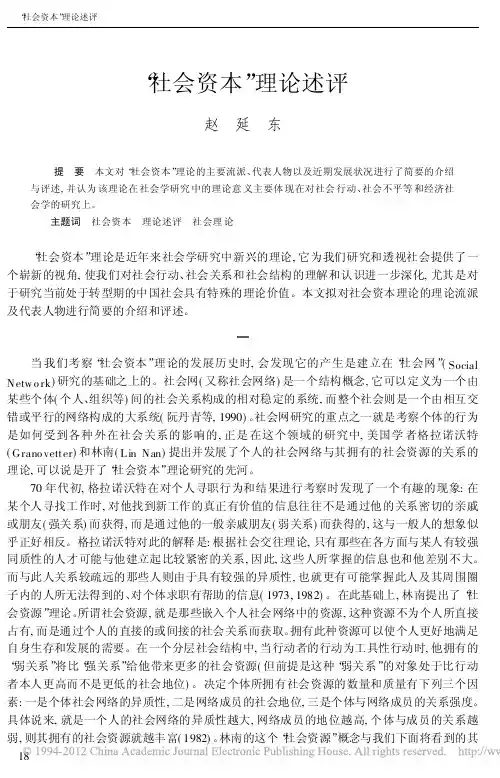
“社会资本”理论述评赵 延 东 提 要 本文对“社会资本”理论的主要流派、代表人物以及近期发展状况进行了简要的介绍与评述,并认为该理论在社会学研究中的理论意义主要体现在对社会行动、社会不平等和经济社会学的研究上。
主题词 社会资本 理论述评 社会理论“社会资本”理论是近年来社会学研究中新兴的理论,它为我们研究和透视社会提供了一个崭新的视角,使我们对社会行动、社会关系和社会结构的理解和认识进一步深化,尤其是对于研究当前处于转型期的中国社会具有特殊的理论价值。
本文拟对社会资本理论的理论流派及代表人物进行简要的介绍和评述。
一当我们考察“社会资本”理论的发展历史时,会发现它的产生是建立在“社会网”(Social Netw o rk)研究的基础之上的。
社会网(又称社会网络)是一个结构概念,它可以定义为一个由某些个体(个人、组织等)间的社会关系构成的相对稳定的系统,而整个社会则是一个由相互交错或平行的网络构成的大系统(阮丹青等,1990)。
社会网研究的重点之一就是考察个体的行为是如何受到各种外在社会关系的影响的,正是在这个领域的研究中,美国学者格拉诺沃特(Grano vetter)和林南(Lin Nan)提出并发展了个人的社会网络与其拥有的社会资源的关系的理论,可以说是开了“社会资本”理论研究的先河。
70年代初,格拉诺沃特在对个人寻职行为和结果进行考察时发现了一个有趣的现象:在某个人寻找工作时,对他找到新工作的真正有价值的信息往往不是通过他的关系密切的亲戚或朋友(强关系)而获得,而是通过他的一般亲戚朋友(弱关系)而获得的,这与一般人的想象似乎正好相反。
格拉诺沃特对此的解释是:根据社会交往理论,只有那些在各方面与某人有较强同质性的人才可能与他建立起比较紧密的关系,因此,这些人所掌握的信息也和他差别不大。
而与此人关系较疏远的那些人则由于具有较强的异质性,也就更有可能掌握此人及其周围圈子内的人所无法得到的、对个体求职有帮助的信息(1973,1982)。
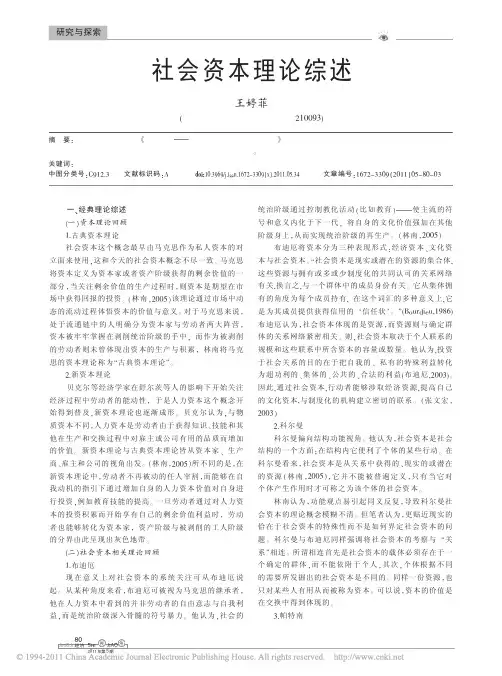
SHI 2011年第5期JINGJI 经济JIAO视角一、经典理论综述(一)资本理论回顾1.古典资本理论社会资本这个概念最早由马克思作为私人资本的对立面来使用,这和今天的社会资本概念不尽一致。
马克思将资本定义为资本家或者资产阶级获得的剩余价值的一部分,当关注剩余价值的生产过程时,则资本是期望在市场中获得回报的投资。
(林南,2005)该理论通过市场中动态的流动过程体悟资本的价值与意义。
对于马克思来说,处于流通链中的人明确分为资本家与劳动者两大阵营,资本被牢牢掌握在剥削统治阶级的手中,而作为被剥削的劳动者则未曾体现出资本的生产与积累,林南将马克思的资本理论称为“古典资本理论”。
2.新资本理论贝克尔等经济学家在舒尔茨等人的影响下开始关注经济过程中劳动者的能动性,于是人力资本这个概念开始得到普及,新资本理论也逐渐成形。
贝克尔认为,与物质资本不同,人力资本是劳动者由于获得知识、技能和其他在生产和交换过程中对雇主或公司有用的品质而增加的价值。
新资本理论与古典资本理论皆从资本家、生产商、雇主和公司的视角出发。
(林南,2005)所不同的是,在新资本理论中,劳动者不再被动的任人宰割,而能够在自我动机的指引下通过增加自身的人力资本价值对自身进行投资,例如教育技能的提高。
一旦劳动者通过对人力资本的投资积累而开始享有自己的剩余价值利益时,劳动者也能够转化为资本家,资产阶级与被剥削的工人阶级的分界由此呈现出灰色地带。
(二)社会资本相关理论回顾1.布迪厄现在意义上对社会资本的系统关注可从布迪厄说起。
从某种角度来看,布迪厄可被视为马克思的继承者,他在人力资本中看到的并非劳动者的自由意志与自我利益,而是统治阶级深入骨髓的符号暴力。
他认为,社会的统治阶级通过控制教化活动(比如教育)———使主流的符号和意义内化于下一代,将自身的文化价值强加在其他阶级身上,从而实现统治阶级的再生产。
(林南,2005)布迪厄将资本分为三种表现形式:经济资本、文化资本与社会资本。

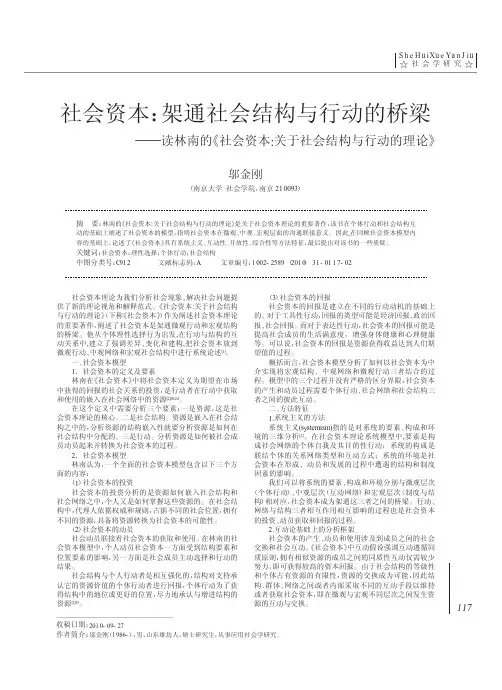
收稿日期:2010-09-27作者简介:邬金刚(1986-),男,山东维坊人,硕士研究生,从事应用社会学研究。
社会资本:架通社会结构与行动的桥梁———读林南的《社会资本:关于社会结构与行动的理论》邬金刚(南京大学社会学院,南京210093)摘要:林南的《社会资本:关于社会结构与行动的理论》是关于社会资本理论的重要著作,该书在个体行动和社会结构互动的基础上阐述了社会资本的模型,指明社会资本在微观、中观、宏观层面的沟通联接意义。
因此,在回顾社会资本模型内容的基础上,论述了《社会资本》具有系统主义、互动性、开放性、综合性等方法特征,最后提出对该书的一些质疑。
关键词:社会资本;理性选择;个体行动;社会结构中图分类号:C 912文献标志码:A 文章编号:1002-2589(2010)31-0117-02社会资本理论为我们分析社会现象、解决社会问题提供了新的理论视角和解释范式。
《社会资本:关于社会结构与行动的理论》(下称《社会资本》)作为阐述社会资本理论的重要著作,阐述了社会资本是架通微观行动和宏观结构的桥梁。
他从个体理性选择行为出发,在行动与结构的互动关系中,建立了强调差异、变化和建构,把社会资本放到微观行动、中观网络和宏观社会结构中进行系统论述[1]。
一、社会资本模型1.社会资本的定义及要素林南在《社会资本》中将社会资本定义为期望在市场中获得的回报的社会关系的投资,是行动者在行动中获取和使用的嵌入在社会网络中的资源[2]18,24。
在这个定义中需要分析三个要素:一是资源,这是社会资本理论的核心。
二是社会结构。
资源是嵌入在社会结构之中的,分析资源的结构嵌入性就要分析资源是如何在社会结构中分配的。
三是行动。
分析资源是如何被社会成员动员起来并转换为社会资本的过程。
2.社会资本模型林南认为,一个全面的社会资本模型包含以下三个方面的内容:(1)社会资本的投资社会资本的投资分析的是资源如何嵌入社会结构和社会网络之中,个人又是如何掌握这些资源的。
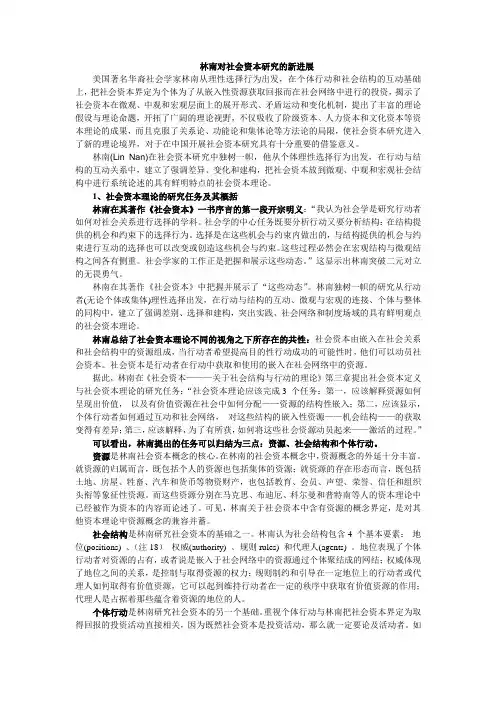
林南对社会资本研究的新进展美国著名华裔社会学家林南从理性选择行为出发,在个体行动和社会结构的互动基础上,把社会资本界定为个体为了从嵌入性资源获取回报而在社会网络中进行的投资,揭示了社会资本在微观、中观和宏观层面上的展开形式、矛盾运动和变化机制,提出了丰富的理论假设与理论命题,开拓了广阔的理论视野,不仅吸收了阶级资本、人力资本和文化资本等资本理论的成果,而且克服了关系论、功能论和集体论等方法论的局限,使社会资本研究进入了新的理论境界,对于在中国开展社会资本研究具有十分重要的借鉴意义。
林南(Lin Nan)在社会资本研究中独树一帜,他从个体理性选择行为出发,在行动与结构的互动关系中,建立了强调差异、变化和建构,把社会资本放到微观、中观和宏观社会结构中进行系统论述的具有鲜明特点的社会资本理论。
1、社会资本理论的研究任务及其概括林南在其著作《社会资本》一书序言的第一段开宗明义:“我认为社会学是研究行动者如何对社会关系进行选择的学科。
社会学的中心任务既要分析行动又要分析结构:在结构提供的机会和约束下的选择行为。
选择是在这些机会与约束内做出的,与结构提供的机会与约束进行互动的选择也可以改变或创造这些机会与约束。
这些过程必然会在宏观结构与微观结构之间各有侧重。
社会学家的工作正是把握和展示这些动态。
”这显示出林南突破二元对立的无畏勇气。
林南在其著作《社会资本》中把握并展示了“这些动态”。
林南独树一帜的研究从行动者(无论个体或集体)理性选择出发,在行动与结构的互动、微观与宏观的连接、个体与整体的同构中,建立了强调差别、选择和建构,突出实践、社会网络和制度场域的具有鲜明观点的社会资本理论。
林南总结了社会资本理论不同的视角之下所存在的共性:社会资本由嵌入在社会关系和社会结构中的资源组成,当行动者希望提高目的性行动成功的可能性时,他们可以动员社会资本。
社会资本是行动者在行动中获取和使用的嵌入在社会网络中的资源。
据此,林南在《社会资本———关于社会结构与行动的理论》第三章提出社会资本定义与社会资本理论的研究任务:“社会资本理论应该完成3 个任务:第一,应该解释资源如何呈现出价值,以及有价值资源在社会中如何分配——资源的结构性嵌入;第二,应该显示,个体行动者如何通过互动和社会网络,对这些结构的嵌入性资源——机会结构——的获取变得有差异;第三,应该解释,为了有所获,如何将这些社会资源动员起来——激活的过程。

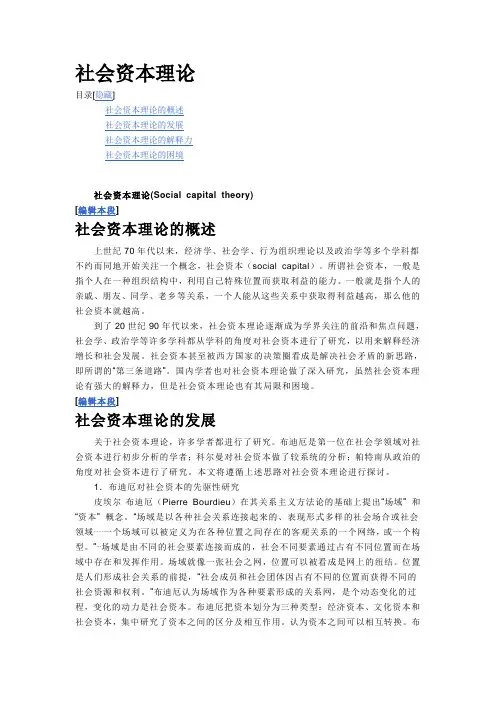
社会资本理论目录[隐藏]社会资本理论的概述社会资本理论的发展社会资本理论的解释力社会资本理论的困境社会资本理论(Social capital theory)[编辑本段]社会资本理论的概述上世纪70年代以来,经济学、社会学、行为组织理论以及政治学等多个学科都不约而同地开始关注一个概念,社会资本(social capital)。
所谓社会资本,一般是指个人在一种组织结构中,利用自己特殊位置而获取利益的能力。
一般就是指个人的亲戚、朋友、同学、老乡等关系,一个人能从这些关系中获取得利益越高,那么他的社会资本就越高。
到了20世纪90年代以来,社会资本理论逐渐成为学界关注的前沿和焦点问题,社会学、政治学等许多学科都从学科的角度对社会资本进行了研究,以用来解释经济增长和社会发展。
社会资本甚至被西方国家的决策圈看成是解决社会矛盾的新思路,即所谓的“第三条道路”。
国内学者也对社会资本理论做了深入研究,虽然社会资本理论有强大的解释力,但是社会资本理论也有其局限和困境。
[编辑本段]社会资本理论的发展关于社会资本理论,许多学者都进行了研究。
布迪厄是第一位在社会学领域对社会资本进行初步分析的学者;科尔曼对社会资本做了较系统的分析;帕特南从政治的角度对社会资本进行了研究。
本文将遵循上述思路对社会资本理论进行探讨。
1.布迪厄对社会资本的先驱性研究皮埃尔·布迪厄(Pierre Bourdieu)在其关系主义方法论的基础上提出“场域” 和“资本” 概念。
“场域是以各种社会关系连接起来的、表现形式多样的社会场合或社会领域⋯⋯一个场域可以被定义为在各种位置之间存在的客观关系的一个网络,或一个构型。
”⋯场域是由不同的社会要素连接而成的,社会不同要素通过占有不同位置而在场域中存在和发挥作用。
场域就像一张社会之网,位置可以被看成是网上的纽结。
位置是人们形成社会关系的前提,“社会成员和社会团体因占有不同的位置而获得不同的社会资源和权利。
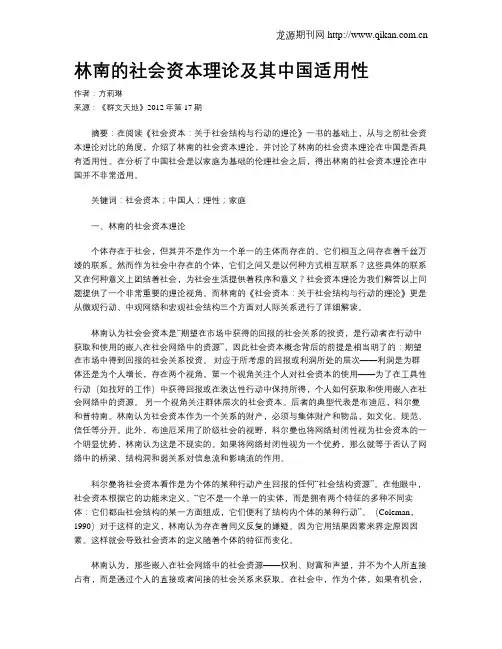
林南的社会资本理论及其中国适用性作者:方莉琳来源:《群文天地》2012年第17期摘要:在阅读《社会资本:关于社会结构与行动的理论》一书的基础上,从与之前社会资本理论对比的角度,介绍了林南的社会资本理论,并讨论了林南的社会资本理论在中国是否具有适用性。
在分析了中国社会是以家庭为基础的伦理社会之后,得出林南的社会资本理论在中国并不非常适用。
关键词:社会资本;中国人;理性;家庭一、林南的社会资本理论个体存在于社会,但其并不是作为一个单一的主体而存在的。
它们相互之间存在着千丝万缕的联系。
然而作为社会中存在的个体,它们之间又是以何种方式相互联系?这些具体的联系又在何种意义上团结着社会,为社会生活提供着秩序和意义?社会资本理论为我们解答以上问题提供了一个非常重要的理论视角。
而林南的《社会资本:关于社会结构与行动的理论》更是从微观行动、中观网络和宏观社会结构三个方面对人际关系进行了详细解读。
林南认为社会会资本是“期望在市场中获得的回报的社会关系的投资,是行动者在行动中获取和使用的嵌入在社会网络中的资源”,因此社会资本概念背后的前提是相当明了的:期望在市场中得到回报的社会关系投资。
对应于所考虑的回报或利润所处的层次——利润是为群体还是为个人增长,存在两个视角。
第一个视角关注个人对社会资本的使用——为了在工具性行动(如找好的工作)中获得回报或在表达性行动中保持所得,个人如何获取和使用嵌入在社会网络中的资源。
另一个视角关注群体层次的社会资本。
后者的典型代表是布迪厄,科尔曼和普特南。
林南认为社会资本作为一个关系的财产,必须与集体财产和物品,如文化、规范、信任等分开。
此外,布迪厄采用了阶级社会的视野,科尔曼也将网络封闭性视为社会资本的一个明显优势,林南认为这是不现实的。
如果将网络封闭性视为一个优势,那么就等于否认了网络中的桥梁、结构洞和弱关系对信息流和影响流的作用。
科尔曼将社会资本看作是为个体的某种行动产生回报的任何“社会结构资源”。

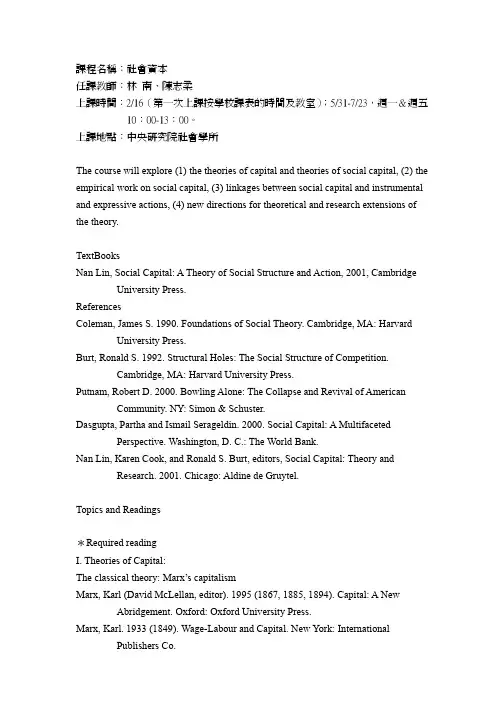
林The course will explore (1) the theories of capital and theories of social capital, (2) the empirical work on social capital, (3) linkages between social capital and instrumental and expressive actions, (4) new directions for theoretical and research extensions of the theory.TextBooksNan Lin, Social Capital: A Theory of Social Structure and Action, 2001, Cambridge University Press.ReferencesColeman, James S. 1990. Foundations of Social Theory. Cambridge, MA: Harvard University Press.Burt, Ronald S. 1992. Structural Holes: The Social Structure of Competition.Cambridge, MA: Harvard University Press.Putnam, Robert D. 2000. Bowling Alone: The Collapse and Revival of American Community. NY: Simon & Schuster.Dasgupta, Partha and Ismail Serageldin. 2000. Social Capital: A Multifaceted Perspective. Washington, D. C.: The World Bank.Nan Lin, Karen Cook, and Ronald S. Burt, editors, Social Capital: Theory and Research. 2001. Chicago: Aldine de Gruytel.Topics and ReadingsRequired readingI. Theories of Capital:The classical theory: Marx’s capitalismMarx, Karl (David McLellan, editor). 1995 (1867, 1885, 1894). Capital: A New Abridgement. Oxford: Oxford University Press.Marx, Karl. 1933 (1849). Wage-Labour and Capital. New York: International Publishers Co.*Brewer, Anthony. 1984. A Guide to Marx's Capital. Cambridge: Cambridge University Press.The Neo-capital theories:Human Capital:Johnson, Harry G. 1960. "The Political Economy of Opulence." Canadian Journal of Economics and Political Science 26:552-64.* Schultz, Theodore W. 1961. "Investment in Human Capital." The American Economic Review LI(1):1-17, 1.Becker, Gary S. 1964/1993. Human Capital. Chicago: University of Chicago Press.Cultural Capital:Bourdieu, Pierre. 1972/1977. Outline of a Theory of Practice. Cambridge: Cambridge University Press.Bourdieu, Pierre and Jean-Claude Passeron. 1977. Reproduction in Education, Society, Culture. Beverly Hills: Sage. Book 1.* Jenkins, Richard. 1992. Pierre Bourdieu. London: Loutledge. Chapter 5.* Lin, 2001, Chapter 1. Theories of Capital: The Historical FoundationII. Social Capital: Defining and ConceptualizingSocial Networks and Embedded ResourcesFormative Works→Interactions and Homophily*Homans, George C. 1950. The Human Group. NY: Harcourt, Brace. Chapters 2, 4, and 6.*Lazarsfeld, Paul F. and Robert K. Merton. 1954. "Friendship as Social Process: A Substantive and Methodological Analysis." Pp. 298-348 in The VariedSociology of Paul F. Lazarsfeld, edited by P. L. Kendall. NY: ColumbiaUniversity Press.Marsden, Peter V. 1988. "Homogeneity in Confiding Networks." Social Networks 10:57-76.→Network Locations and Tie Strength:*Granovetter, Mark. 1973. "The Strength of Weak Ties." American Journal of Sociology 78:1360-80.________. 1974. Getting a Job. Cambridge, MA: Harvard University Press.________. 1982. "The Strength of Weak Ties: A Network Theory Revisited." Pp.105-30 in Social Structure and Network Analysis, edited by Peter V.Marsden and Nan Lin. Beverly Hills, CA: Sage.*Lin, Nan, Paul Dayton, and Peter Greenwald. 1978. "Analyzing the Instrumental Use of Relations in the Context of Social Structure." Sociological Methods andResearch 7:149-66.Marsden, Peter V. and Karen E. Campbell. 1984. "Measuring Tie Strength." Social Forces 63 (December):482-501.*Burt, Ronald S. 1992. Structural Holes: The Social Structure of Competition.Cambridge, MA: Harvard University Press.2002 “ 聯 度 理” 163-209.Conceptualizing*Lin, Nan. 1982. "Social Resources and Instrumental Action." Pp. 131-45 in Social Structure and Network Analysis, edited by Peter V. Marsden and Nan Lin.Beverly Hills, CA: Sage.*Bourdieu, Pierre. 1983/1986. "The Forms of Capital." Pp. 241-58 in Handbook of Theory and Research for the Sociology of Education, edited by John G.Richardson. Westport, CT.: Greenwood Press.________. 1980. "Le Capital Social: Notes Provisoires." Actes de la Recherche en Sciences Sociales 3:2-3.*Coleman, James S. 1990. Foundations of Social Theory. Cambridge, MA: Harvard University Press. Chapter 12.Pizzorno, Alessandro. 1991. "On the Individualistic Theory of Social Order." Pp.209-31 in Social Theory for a Changing Society, edited by Pierre Bourdieuand James S. Coleman. Boulder, Colorado: Westview.Additional Readings→ Embedded Resources and StructureSewell, William H., Jr. 1992. "A Theory of Structure: Duality, Agency, andTransformation." American Journal of Sociology 98(1):1-29.→ Values of Embedded ResourcesWeber, Max. 1946. Max Weber: Essays in Sociology (Translated by H. H. Gerth andC. Wright Mills). New York: Oxford University Press.Burt, Ron. 1997. "The Contingent Value of Social Capital." Administrative Science Quarterly 42:339-65.→ Integrating*Lin, Chapters 2, 3, 4, 5ch2. Social Capital: Capital Captured through Social Relationsch3. Resources, Hierarchy, Networks, and Homophily: The Structural Foundationch4. Resources, Motivations, and Interactions: The Action Foundationch5. The Theory and Theoretical Propositions*Ronald S. Burt. 2001. "Structural Holes Versus Network Closure as Social Capital."InSocial Capital: Theory and Research, edited by N. Lin, K. Cook and R. S.Burt. Hawthorn, NY: Aldine de Gruyter.Civic Engagement*Coleman, James S. 1990. Foundations of Social Theory. Cambridge, MA: Harvard University Press. (Especially Chapter 12, pp. 360-363, 590-597)*Putnam, Robert D. 1993. Making Democracy Work: Civic Traditions in Modern Italy.Princeton, N. J.: Princeton University Press.Generalized Trust*Coleman, James S. 1990. Foundations of Social Theory. Cambridge, MA: Harvard University Press. (Especially Chapter 12, pp. 360-363, 590-597)*Putnam, Robert D. 1995b. "Tuning In, Tuning Out: The Strange Disappearance of Social Capital in America." The 1995 Itheiel de Sola Pool Lefcture.American Political Science Association. September.III. Empirical Evidence of Social CapitalSocial Resources Theory*Lin, Nan, Walter M. Ensel, and John C. Vaughn. 1981. "Social Resources and Strength of Ties: Structural Factors in Occupational Status Attainment."American Sociological Review 46(4):393-405.*Marsden, Peter V. and Jeanne S. Hurlbert. 1988. "Social Resources and Mobility Outcomes: A Replication and Extension." Social Forces 66(4):1038-59, 4. *De Graaf, Nan Dirk and Hendrik Derk Flap. 1988. "With a Little Help from My Friends." Social Forces 67(2):452-72.Flap, Hendrik Derk and Nan Dirk De Graaf. 1988. "Social Capital and Attained Occupational Status." Netherlands Journal of Sociology.Boxman, E. A., W., P. M. de Graaf, and Henk D. Flap. 1991. "The Impact of Social and Human Capital on the Income Attainment of Dutch Managers." SocialNetworks 13:51-73.. 1992. " " 16:107-38.*Bian, Yanjie. 1997. "Bringing Strong Ties Back In: Indirect Connection, Bridges, and Job Search in China." American Sociological Review 62(3):36-385, 3. Bian, Yanjie and Soon Ang. 1997. "Guanxi Networks and Job Mobility in China and Singapore." Social Forces 75:981-1006.Name Generator versus Position Generator: Methodological Debates and Advances:*Campbell, Karen E., Peter V. Marsden, and Jeanne S. Hurlbert. 1986. "Social Resources and Socioeconomic Status." Social Networks 8(1).Ron Burt. 1998. "The Gender of Social Capital." Rationality and Society 10(1):5-46,1.*Lin, Nan and Mary Dumin. 1986. "Access to Occupations Through Social Ties."Social Networks 8:365-85.*Erickson, Bonnie H. 1996. "A Structural Approach to Network and Cultural Resources." American Journal of Sociology.*Lin, Nan, Yang-chih Fu, and Ray-may Hsung. 1998. "Position Generator: A Measurement for Social Capital." Social Networks and Social Capital. DukeUniversity, November.Structural PositionsGeletkanycz, Marta A. and Donald C. Hambrick. 1997. "The External Ties of Top Exectuvies: Implications for Strrategic Choice and Performance."Administrative Science Quarterly 42:654-81.Pennings, Johannes M., Kyungmook Lee, and Arjen van Witteloostuijn. 1998."Human Capital, Social Capital, and Firm Dissolution." Academy ofManagement Science 41:425-40.Stuart, Toby E. and Joel M. Podolny. 1999. "Positional Causes and Correlates of Strategic Alliances in the Semiconductor Industry." Pp. 161-82 in Researchin the Sociology of Organizations, edited by S. Andrews and D. Knoke.Greenwich, CT: JAI Press.Baum, Joel A. C., Tony Calabrese, and Brian S. Silverman. 2000. "Don't Go It Alone: Alliance Network Composition and Startups' Performances in CanadianBiotechnology." Strategic Management Journal 21:267-94.Burt, Ronald S. 2000. "The Network Structure of Social Capital." Pp. 345-423 in Research in Organizational Behavior, edited by R. I. Sutton and B. M. Staw.Greenwich, CT: JAI Press.____ 2001. "Structural Holes Versus Network Closure as Social Capital." In Social Capital: Theory and Research, edited by N. Lin, K. Cook and R. S. Burt.Hawthorn, NY: Aldine de Gruyter.Civic Engagement*Putnam, Robert D. 2000. Bowling Alone: The Collapse and Revival of American Community. NY: Simon & Schuster.Putnam, Robert D. 1995a. "Bowling Alone, Revisited." The Responsive Community, Spring, 18-33.Putnam, Robert D. 1995b. "Tuning In, Tuning Out: The Strange Disappearance of Social Capital in America." The 1995 Itheiel de Sola Pool Lefcture.American Political Science Association. September.Greeley, Andrew. 1997a. "Coleman Revisited: Religious Structures as a Source of Social Capital." American Behavioral Scientist 40(5, March/April):587-94. ____ 1997b. "The Other Civic America: Religion and Social Capital." The American Prospect 32 (May-June):68-73.____ 1997c. "The Strange Reappearance of Civic America: Religion andV olunteering," Department of Sociology, University of Chicago. Paxton, Pamela. 1999. "Is Social Capital Declining in the United States? A Multiple Indicator Assessment." American Journal of Sociology 105(1, July):88-127. Lemann, Nicholas. 1996. "Kicking in Groups." The Atlantic Monthly, April, pp.22-26.Samuelson, Robert. 1996? "The "Bowling Alone" Phenomenon Is Bunk." Detroit News (Detroit).Schudson, Michael. 1996. "What If Civic Life Didn't Die?" The American Prospect 25 (March-April):17-20.Wolfinger, Raymond E and Steven J. Rosenstone. 1980. Who V otes. New Haven, CT: Yale University Press.Verba, Sidney, Norman H. Nie, and Jae-on Kim. 1978. Participation and Political Equality: A Seven-Nation Comparison. Cambridge: Cambridge UniversityPress.Verba, Sidney, Kay Lehman Schlozman, and Henry E. Brady. 1995. V oice and Equality: Civic V oluntarism in American Politics. Cambridge, MA: HarvardUniversity Press.____ 1997. "The Big Tilt: Participatory Inequality in America." The American Prospect 32 (May-June):74-80.Generalized TrustPutnam, Robert D. 2000. Bowling Alone: The Collapse and Revival of American Community. NY: Simon & Schuster.Lochner, Kimberly, Ichiro Kawachi,and Bruce P. Kennedy. 1999. "Social Capital: A Guide to Its Measurement."Health and Place 5:259-70.Kenneday, B. P., I. Kawachi, and E. Brainerd. 1998. "The Role of Social Capital in the Russian Mortality Crisis." World Development 26:2029-43.Kawachi, Ichiro and Lisa Berkman. 2000. "Social Cohesion, Social Capital, and Health." Pp. 174-90 in Social Epidemiology, edited by L. Berkman and I.Kawachi. NY: Oxford University Press.Kawachi, Ichiro, Bruce P. Kenneday, Kimberly Lochner, and D. Prothrow-Stith.1997b. "Social Capital, Income Inequality and Mortality." American Journalof Public Health 87:1491-98.Kawachi, Ichiro, Bruce P. Kennedy, and Roberta Glass. 1999. "Social Capital and Self-Rated Health: A Contextual Analysis." American Journal of PublicHealth 89(8):1187-93.Kawachi, Ichiro, Bruce P. Kennedy, and Kimberly Lochner. 1997a. "Long Live Community: Social Capital as Public Health." The American Prospect 35(November-December):56-59.Torsvik, Gaute. 2000. "Social Capital and Development: A Plea for the Mechanisms."Rationality and Society 12(4):451-76.Sociological analysis of trustDurkheim, Emile. 1956. The Division of Labor in Society. New York: Free Press. Simmel, Georg (ed. Donald N. Levine). 1971. Georg Simmel on Individuality and Social Forms. Chicago: University of Chicago Press.Simmel, Georg (trans. and edited by Kurt H. Wolff). 1950. The Sociology of Georg Simmel. Glencoe, Ill.: Free Press.Simmel, Georg. 1978. The Philosophy of Money. London: Routledge.Parsons, Talcott. 1963. "On the Concept of Influence." Public Opinion Quarterly 27:37-62.Luhmann, N. 1979. Trust and Power. Chichester: Wiley.Barber, Bernard. 1983. The Logic and Limits of Trust. New Brunswick, NJ: Rutgers University Press.Misztal, Barber A. 1996. Trust in Modern Societies. Cambridge, UK: Polity.Economical analysis of trustWilliamson, Oliver E. 1985. The Economic Institutions of Capitalism. New York: Free Press.____1993. "Calculativeness, Trust, and Economic Organization." Journal of Law and Economics 36(1-2, April):453-86.IV. ExtensionsSocial Capital in Institutional TransformationV olker, Beate and Henk Flap. 1996. "Getting Ahead in the GDR: Human Capital and Social Capital in the Status Attainment Process Under Communism."Universiteit Utrecht, the Netherlands.Angelusz, Robert and Robert Tardos. 1998. "Shifts in Access to Social Network Resources in Hungary Under Transformation." Social Networks and SocialCapital. Duke University, November.Collective Social Capital*Portes, Alejandro and Julia Sensenbrenner. 1993. "Embeddedness and Immigration:Notes on the Social Determinants of Economic Action." American Journalof Sociology 98(6):1320-50, 6.Hagan, John, Ross MacMillan, and Blair Wheaton. 1996. "New Kid in Town: Social Capital and the Life Course Effects of Family Migration on Children."American Sociological Review 61:368-85.Sampson, Robert J., Jeffrey D. Morenoff, and Felton Earls. 1999. "Spatial Dynamics of Collective Efficacy for Children." American Sociological Review 64(5,October):633-60.Social Capital and Inequality*Green, Gary P., Leann M. Tigges, and Irene Browne. 1995. "Social Resources, Job Search, and Poverty in Atlanta." Research in Community Sociology5:161-82.*Lin, 2001. Chapter 7. AInequality in Social Capital: A Research Agenda: V. Syntheses and DebatesMark Granovetter. 1995. Getting a Job (Revised Edition). Chicago: University of Chicago Press.*Portes, Alex. 1998. "Social Capital: Its Origins and Applications in Modern Sociology." Annual Review of Sociology 22:1-24.*Lin, Nan. 1999. Social Networks and Status Attainment. Annual Review of Sociology. Or, Lin, 2001, Chapter 6.*Woolcock, Michael. 1998. "Social Capital and Economic Development: Toward a Theoretical Synthesis and Policy Framework." Theory and Society27:151-208.*Woolcock, Michael and Deepa Narayan. 2000. "Social Capital: Implications for Development Theory, Research, and Policy." The World Bank ResearchObserver 15(2, August):225-49.Serageldin, Ismail and Christiaan Grootaert. 2000. "Defining Social Capital: An Integrating View." Pp. 40-58 in Social Capital: A Multifaceted Perspective,edited by P. Dasgupta and I. Serageldin. Washington, D. C.: The WorldBank.* Foley, Michael W. and Bob Edwards. 1999. "Is It Time to Disinvest in Social Capital." Journal of Public Policy 19(2):141-73.Sandefur, Rebecca L. and Edward O. Laumann. 1998. "A Paradigm for Social Capital." Rationality and Society 10:481-95.Starr, Paul. [August 14] 2000. "The Public Vanishes," by R. D. Putnam, The New Republic, 35-37Bowling Alone: The Collapse and Revival of AmericanCommunity. Simon & Schuster.*Marsden, Peter V. and Elizabeth H. Gorman. Forthcoming. "Social Networks, Job Changes, and Recruitment." In Sourcebook on Labor Markets: EvolvingStructures and Processes, edited by I. Berg and A. L. Kalleberg.Lynch, J., P. Due, C. Muntaner, and G. Davey Smith. 2000. "Social Capital -- Is It a Good Investment Strategy for Public Health." Journal of Epidemiology andCommunity Health 54:404-08.Baum, Francis E. 2000. "Social Capital, Economic Capital and Power: Further Issues for a Public Health Agenda." Journal of Epidemiology and CommunityHealth 54:409-10.Wrong, Dennis. 1961. "The Oversocialized Conception of Man in Modern Sociology." American Sociological Review 26(2):183-93. Granovetter, Mark. 1985. "Economic and Social Structure: The Problem of Embeddedness." American Journal of Sociology 91:481-510.Zhou, Xueguang., Zhao Wei., Li Qiang., and Cai He (2003) ‘Embeddedness and contractual relationships in China’s transitional economy’, AmericanSociological Review, 68: 75-102.VI. Theoretical ExtensionsEmergence of Social Capital*Nan Lin. 1994a. "Action, Social Resources, and the Emergence of Social Structure:A Rational Choice Theory." Advances in Group Processes 11:67-85. Or, Lin,2001, Chapter 8. Social Capital and the Emergence of Social Structure: ATheory of Rational ChoiceSocial Exchange and Reputation: Rent of Social CapitalSmart, Alan. 1993. "Gifts, Bribes, and Guanxi: A Reconsideration of Bourdieu's Social Capital." Cultural Anthropology 8(3):388-408, 3.Nan Lin. 1997. "Guanxi: A Conceptual Analysis." Annual Meeting of the American Sociological Association. Toronto, August 8.*Nan Lin, 2001, Chapter 9. Reputation and Social Capital: The Rational Basis of Social ExchangeSocial Capital in OrganizationsLin, 2001, Chapter 10. Social Capital in Hierarchical StructuresOr, Nan Lin. 1990. "Social Resources and Social Mobility: A Structural Theory of Status Attainment." Pp. 247-171 in Social Mobility and Social Structure,edited by Ronald L. Breiger. NY: Cambridge University Press.Social Capital and Social ChangeNan Lin. 1995d. "Institutions and Networks: The Infrastructure of Society."International Social Network Conference. London, July 6-10. Or, Lin, 2001.Chapter 11. Institutions, Networks and Capital Building: SocietalMaintenance and TransformationsAscent of Social Capital: Cybernetworks*Nan Lin, 2001. Chapter 12.Cybernetworks: The Rise of Social Capital*Nan Lin, Bai Gao, and Marc Magee. 2001. ACybernetworks and the Social Capital-Based Economy.Additional readingsBrecher, Jeremy and Tim Costello. 1998. Global Village or Global Pillage. Costells, Manuel. 1998. End of Millennium. Blackwell.Costells, Manuel. 1996. The Rise of the Network Society. Blackwell.________. 1997. The Power of Identity: The Information - Economy, Society and Culture. Blackwell.Graham, Stephen and Simon Marvin. 1996. Telecommunications and the City: Electronic Spaces, Urban Places. London: Rutledge.Kelly, Kevin. New Rules for the New Economy: Ten Radical Strategies for a Connected World. Penguin Putnum.McLuhan, Marshall and Bruce R. Powers. 1992. The Global Village: Transformations in World Life and Media in the 21st Century. NY: Oxford University Press. Mulgan, Geoff. Connexity: How to Live In a Connected World. Cambridge, MA: Harvard Business School Press.Sassen, Saskia. 1998. Globalization and Its Discontents. New Press.Wellman, Barry. ed. 1998. Networks in the Global Village. Boulder, CO: Westview Press.References李 , 2000. 北 羅 ‧ 列, 來 : 利 , 2001[ 90]‧ 理論 北 : , 1999.Angelusz, Robert and Robert Tardos. 1991. "The Strength and Weakness of "Weak Ties"." Pp. 7-23 in Values, Networks and Cultural Reproduction in Hungary,edited by P. Somlai. Budapest: The Coordinating Council of Programs. Angelusz, Robert and Robert Tardos. 1991. "The Strength and Weakness of "Weak Ties"." Pp. 7-23 in Values, Networks and Cultural Reproduction in Hungary,edited by P. Somlai. Budapest: The Coordinating Council of Programs. Barber, Bernard. 1983. The Logic and Limits of Trust. New Brunswick, NJ: Rutgers University Press.Barbieri, Paolo. 1996. "Household, Social Capital and Labour Market Attainment."ECSR Workshop. Max Planck Institute for Human Development andEducation, Berlin, August 26-27.Baum, Francis E. 2000. "Social Capital, Economic Capital and Power: Further Issues for a Public Health Agenda." Journal of Epidemiology and Community Health 54:409-10.Baum, Joel A. C., Tony Calabrese, and Brian S. Silverman. 2000. "Don't Go It Alone: Alliance Network Composition and Startups' Performances in CanadianBiotechnology." Strategic Management Journal 21:267-94.Becker, Gary S. 1964/1993. Human Capital. Chicago: University of Chicago Press. Bian, Yanjie. 1995. "China: Getting a Job in a Web of Guanxi." In Networks in the Global Village, edited by Barry Wellman. Boulder, CO: Westview.Bian, Yanjie. Forthcoming-a. "Bringing Strong Ties Back In: Indirect Connection, Bridges, and Job Search in China." American Sociological Review.________. forthcoming-b. "Getting a Job Through a Web of Guanxi in Urban China."In Networks in the Global Village, edited by Barry Wellman. Boulder, CO:Westview.Bian, Yanjie and Soon Ang. forthcoming. "Guanxi Networks and Job Mobility in China and Singapore." Social Forces.Bourdieu, Pierre. 1972/1977. Outline of a Theory of Practice. Cambridge: Cambridge University Press.________. 1980. "Le Capital Social: Notes Provisoires." Actes de la Recherche en Sciences Sociales 3:2-3.________. 1983/1986. "The Forms of Capital." Pp. 241-58 in Handbook of Theory and Research for the Sociology of Education, edited by John G. Richardson.Westport, CT.: Greenwood Press.________. 1990. The Logic of Practice. Cambridge: Polity.Bourdieu, Pierre and Jean-Claude Passeron. 1977. Reproduction in Education, Society, Culture. Beverly Hills: Sage.Boxman, Ed. 1992. "Contacts and Careers." diss, the Netherlands: University of Utrecht.Boxman, E. A., W. and Hendrik Derk Flap. 1990. "Social Capital and Occupational Chances." The International Sociological Association XII World Congress ofSociology. Madrid, July.Boxman, E. A., W., P. M. de Graaf, and Henk D. Flap. 1991. "The Impact of Social and Human Capital on the Income Attainment of Dutch Managers." SocialNetworks 13:51-73.Boxman, E. A., W., Hendrik Derk Flap, and P. M. De Graaf. 1989. "Social Capital, Human Capital, and Income Attainment: The Impact of Social Capital andHuman Capital on the Income Attainment of Dutch Managers in 1986." TheEuropean Conference on Social Network Analysis. Groningen, Netherlands,June.Brecher, Jeremy and Tim Costello. 1998. Global Village or Global Pillage. Brewer, Anthony. 1984. A Guide to Marx's Capital. Cambridge: Cambridge University Press.Browne, Ray Broadus and Marshall William Fishwick. 1998. The Global Village: Dead or Alive. Bowling Green State University.Burt, Ronald S. 1992. Structural Holes: The Social Structure of Competition.Cambridge, MA: Harvard University PressBurt, Ronald S. 1995. "The Contingent Value of Social Capital." University of Chicago Graduate School of Business, April.________. 1997. "The Contingent Value of Social Capital." Administrative Science Quarterly 42:339-65.________. 1998. "The Gender of Social Capital." Rationality and Society 10(1):5-46,1.Burt, Ronald S. 2000. "The Network Structure of Social Capital." Pp. 345-423 inResearch in Organizational Behavior, edited by R. I. Sutton and B. M. Staw.Greenwich, CT: JAI Press.________. 2001. "Structural Holes Versus Network Closure as Social Capital." In Social Capital: Theory and Research, edited by N. Lin, K. Cook and R. S. Burt.Hawthorn, NY: Aldine de Gruyter.Campbell, Karen E., Peter V. Marsden, and Jeanne S. Hurlbert. 1986. "Social Resources and Socioeconomic Status." Social Networks 8(1).Costells, Manuel. 1998. End of Millennium. Blackwell.Costells, Manuel. 1996. The Rise of the Network Society. Blackwell.________. 1997. The Power of Identity: The Information - Economy, Society and Culture. Blackwell.Coleman, James S. 1988. "Social Capital in the Creation of Human Capital."American Journal of Sociology 94:S95-S121.Coleman, James S. 1990. Foundations of Social Theory. Cambridge, MA: Harvard University Press. (Especially Chapter 12, pp. 360-363, 590-597) Dasgupta, Partha and Ismail Serageldin. 2000. Social Capital: A Multifaceted Perspective. Washington, D. C.: The World Bank.De Graaf, Nan Dirk and Hendrik Derk Flap. 1988. "With a Little Help from My Friends." Social Forces 67(2):452-72.DiMaggio, Paul J. and Walter W. Powell. 1991. "Introduction." Pp. 1-38 in The New Institutionalism in Organizational Analysis, edited by Walter W. Powell andPaul J. DiMaggio. Chicago: University of Chicago Press.DiMaggio, Paul. 1988. "Interest and Agency in Institutional Theory." Pp. 3-22 in Institutional Patterns and Organizations: Culture and Environment, edited byLynne G. Zucker. Cambridge, MA: Ballinger.________. 1991. "Social Structure, Institutions, and Cultural Goods: The Case of the United States." Pp. 133-55 in Social Theory for a Changing Society, edited byPierre Bourdieu and James S. Coleman. Boulder: Westview.DiMaggio, Paul. J. and Walter W. Powell. 1983. "The Iron Cage Revisited: Institutional Isomorphism and Collective Rationality in OrganizationalFields." American Sociological Review 48:147-60.Durkheim, Emile. 1956. The Division of Labor in Society. New York: Free Press. Ensel, Walter M. 1979. "Sex, Social Ties, and Status Attainment." Albany, NY: State University of New York at Albany.Erickson, Bonnie H. 1995. "Networks, Success, and Class Structure: A Total View."Sunbelt Social Networks Conference. Charleston, S.C., February. Erickson, Bonnie H. 1996. "A Structural Approach to Network and Cultural Resources." American Journal of Sociology..Fernandez, Roberto M. and Nancy Weinberg. 1996. "Getting a Job: Networks and Hiring in a Retail Bank." Stanford University, March.Flap, Henk D. 1991. "Social Capital in the Reproduction of Inequality." Comparative Sociology of Family, Health and Education 20:6179-202.________. 1994/1995. "No Man Is An Island: The Research Program of a Social Capital Theory." World Congress of Sociology. Bielefeld, Germany, July. Flap, Henk. 1995. "No Man is an Island: The Research Program of a Social Capital Theory." International Network Conference. London, July 6-10.Flap, Hendrik Derk and Nan Dirk De Graaf. 1988. "Social Capital and Attained Occupational Status." Netherlands Journal of Sociology.Foley, Michael W. and Bob Edwards. 1999. "Is It Time to Disinvest in Social Capital."Journal of Public Policy 19(2):141-73.Geletkanycz, Marta A. and Donald C. Hambrick. 1997. "The External Ties of Top Exectuvies: Implications for Strrategic Choice and Performance."Administrative Science Quarterly 42:654-81.Graham, Stephen and Simon Marvin. 1996. Telecommunications and the City: Electronic Spaces, Urban Places. London: Rutledge.Granovetter, Mark. 1973. "The Strength of Weak Ties." American Journal of Sociology 78:1360-80.________. 1974. Getting a Job. Cambridge, MA: Harvard University Press.________. 1982. "The Strength of Weak Ties: A Network Theory Revisited." Pp.105-30 in Social Structure and Network Analysis, edited by Peter V. Marsdenand Nan Lin. Beverly Hills, CA: Sage.________. 1985. "Economic and Social Structure: The Problem of Embeddedness."American Journal of Sociology 91:481-510.________. 1995. Getting a Job (Revised Edition). Chicago: University of Chicago Press.Granovetter, Mark. 1994. Getting a Job (Revised Edition). Chicago: University of Chicago Press.Greeley, Andrew. 1997a. "Coleman Revisited: Religious Structures as a Source of Social Capital." American Behavioral Scientist 40(5, March/April):587-94.________. 1997b. "The Other Civic America: Religion and Social Capital." The。
内容摘要:社会资本是当代西方社会科学研究的一个重要概念和分析工具。
社会资本概念的界定一直以来都是一个有争议的问题,社会资本的概念至今还没有达成共识,大多数学者都是从自己的学科角度对其加以定义和利用。
尽管对于社会资本,不同学者的表述有所不同,但其基本的意义和指向是相同的,都把社会资本定义为一种和物质资本、人力资本相区别的存在于社会结构中的个人资源,它为结构内的行动者提供便利的资源,包括规范、信任和网络等形式。
关键词:资本;社会资本;理论综述一、社会资本概念的提出资本是经济学中的一个基本概念。
资本是经济繁荣和社会发展的一个重要因素,它一直是经济学研究中的一个非常重要的概念。
就其本质而言,资本是一个不断扩展的概念,其内涵随着社会和经济的不断发展而日益丰富。
从亚当•斯密的古典经济学开始,经济学视野中的资本的内涵不断丰富,它指的是一种能够生产产品的物质资本或物质资本的象征物( 货币),并与土地、劳动并列为最基本的推动经济增长的生产要素。
马克思从阶级分析出发最先对资本这一概念进行了科学的界定,他认为资本是能够带来剩余价值的价值,反映了资本家剥削雇佣劳动者的社会关系;同时从动态的角度,进一步分析了资本的运动过程及其价值增殖过程。
在此基础上,马克思揭示了资本主义社会的变迁规律。
随着西方经济学的发展以及经济学在社会科学中主导地位的确立,西方经济学家为克服传统主流经济学的局限性,不断拓展资本的内涵。
特别是20 世纪50 年代美国经济学家舒尔茨和贝克通过对社会经济增长的研究,突破了相对比较狭隘的货币资本和物质资本的局限,首次提出了“人力资本”的概念,并将其定义为个人所具备的知识、才能、技能和资历等要素的总和,是一种“非物质资本”。
但是,无论是物质资本还是人力资本,都只是一种经济性的资本。
而舒尔茨和贝克尔提出的人力资本概念,首次使“资本”的概念摆脱了具体的物质形态而向广义的、抽象的层次扩展,成为可以带来价值增值的所有物质与非物质资源的代名词,从而为社会资本理论的提出奠定了理论基础。
QUN WEN TIAN DI 理论园地摘要:在阅读《社会资本:关于社会结构与行动的理论》一书的基础上,从与之前社会资本理论对比的角度,介绍了林南的社会资本理论,并讨论了林南的社会资本理论在中国是否具有适用性。
在分析了中国社会是以家庭为基础的伦理社会之后,得出林南的社会资本理论在中国并不非常适用。
关键词:社会资本;中国人;理性;家庭一、林南的社会资本理论个体存在于社会,但其并不是作为一个单一的主体而存在的。
它们相互之间存在着千丝万缕的联系。
然而作为社会中存在的个体,它们之间又是以何种方式相互联系?这些具体的联系又在何种意义上团结着社会,为社会生活提供着秩序和意义?社会资本理论为我们解答以上问题提供了一个非常重要的理论视角。
而林南的《社会资本:关于社会结构与行动的理论》更是从微观行动、中观网络和宏观社会结构三个方面对人际关系进行了详细解读。
林南认为社会会资本是“期望在市场中获得的回报的社会关系的投资,是行动者在行动中获取和使用的嵌入在社会网络中的资源”,因此社会资本概念背后的前提是相当明了的:期望在市场中得到回报的社会关系投资。
对应于所考虑的回报或利润所处的层次———利润是为群体还是为个人增长,存在两个视角。
第一个视角关注个人对社会资本的使用———为了在工具性行动(如找好的工作)中获得回报或在表达性行动中保持所得,个人如何获取和使用嵌入在社会网络中的资源。
另一个视角关注群体层次的社会资本。
后者的典型代表是布迪厄,科尔曼和普特南。
林南认为社会资本作为一个关系的财产,必须与集体财产和物品,如文化、规范、信任等分开。
此外,布迪厄采用了阶级社会的视野,科尔曼也将网络封闭性视为社会资本的一个明显优势,林南认为这是不现实的。
如果将网络封闭性视为一个优势,那么就等于否认了网络中的桥梁、结构洞和弱关系对信息流和影响流的作用。
科尔曼将社会资本看作是为个体的某种行动产生回报的任何“社会结构资源”。
在他眼中,社会资本根据它的功能来定义。
新经济社会学中社会网络理论和社会资本理论比较理论综述新经济社会学是一门运用社会学的理论方法来研究经济现象的学科,下面是搜集整理的一篇探究社会网络理论和社会资本理论比较的,欢迎阅读参考。
引言经济社会学创立于19世纪末,先后经历了三大发展阶段,分别是20世纪初的形成阶段、20世纪60年代的传统阶段以及20世纪80年代后的复兴阶段(刘少杰,2009)。
新经济社会学(NewEco-nomicSociology)即经济社会学的当代演进,是一门运用社会学的理论和方法来研究经济行为及经济体系的科学(曹德骏、左世翔,2012)。
新经济社会学的重要价值在于对古典、新古典经济学思想所提出的反驳。
新古典经济学中对于完全理性经济人和完全自由竞争市场的假设在Granovetter等学者看来是某种错误的观点。
他们认为,由于新古典经济学忽视了人的能力,没有看到社会网络及其规范对于经济活动的影响,其研究必然与现实情况不符。
因此,新经济社会学理论是对传统经济、管理理论的补充和纠正,值得我们借鉴并加以丰富。
二十世纪八十年代以来,随着Granovetter(1985)所作的《经济行动与社会结构:有关嵌入性问题》一文的发表,他开创了经济社会学的全新时代,由此也奠定了运用社会网络视角来研究经济行为的恰当理论基础(汪和建,2006)。
随后,社会网络及社会资本引起了众多学者(Ports,1998;Powell,1990;Baker,2006)的关注,渐渐成为了研究经济管理类各种问题的关键方法和重要视角(耿新,2010)。
新经济社会学的研究内容主要包括五个方面:社会网络研究、市场研究、企业研究、性别研究和文化研究。
本文将通过理论梳理的方式比较研究其中的社会网络理论和社会资本理论。
理论综述新经济社会学是一门运用社会学的理论方法来研究经济现象的学科。
这一理论建立在三大基础性假设之上(Granovetter,1992)。
第一,经济行动镶嵌于社会关系网络之中;第二,经济行动将追寻经济与非经济的目标;第三,经济体制是社会学的构建。